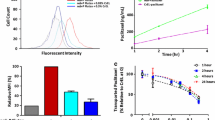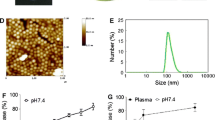Abstract
Nanomedicines can generally only reach cancer cells at the edges of tumors, leaving most tumor cells in the central regions untreated. Previous studies showed that treatment with the vascular disrupting agent combretastatin-A4-phosphate (CA4P) can disrupt tumor vasculature, causing vascular shutdown and leading to massive necrosis in the tumor core. In this research, we explored the effect of co-administration of CA4P on the antitumor activity of nanoparticle albumin-bound paclitaxel (nab-paclitaxel) in Walker 256 tumor-bearing rats. The iodine 131 isotope was used for tracing and biodistribution analysis of nab-paclitaxel uptake. Liquid chromatography coupled with tandem mass spectrometry was performed to detect the intratumoral concentration of paclitaxel. Magnetic resonance imaging (MRI) was used to evaluate the effect of tumor treatment. Biodistribution results demonstrated that the tumor accumulations of both nab-paclitaxel and paclitaxel in the 131I-nab-paclitaxel + CA4P group were much higher than those in the 131I-nab-paclitaxel group. Nab-paclitaxel in combination with CA4P inhibited tumor growth significantly more potently compared with the CA4P group, nab-paclitaxel group and PBS group. Our results demonstrate that co-administration of CA4P increased the intratumoral accumulation of nab-paclitaxel and improved its therapeutic effect compared with single treatments.





Similar content being viewed by others
References
Matsumura Y, Maeda H (1986) A new concept for macromolecular therapeutics in cancer chemotherapy: mechanism of tumoritropic accumulation of proteins and the antitumor agent smancs. Cancer Res 46:6387–6392
Maeda H, Nakamura H, Fang J (2013) The EPR effect for macromolecular drug delivery to solid tumors: improvement of tumor uptake, lowering of systemic toxicity, and distinct tumor imaging in vivo ☆. Adv Drug Deliv Rev 65:71–79
Moon JH Jr, Moxley J, Zhang P, Cui H (2015) Nanoparticle approaches to combating drug resistance. Future Med Chem 7:1503
Petrelli F, Borgonovo K, Barni S (2010) Targeted delivery for breast cancer therapy: the history of nanoparticle-albumin-bound paclitaxel. Expert Opin Pharmacother 11:1413
Sykes EA, Chen J, Zheng G, Chan WC (2014) Investigating the impact of nanoparticle size on active and passive tumor targeting efficiency. ACS Nano 8:5696–5706
Yuan F, Leunig M, Huang SK, Berk DA, Papahadjopoulos D, Jain RK (1994) Microvascular permeability and interstitial penetration of sterically stabilized (stealth) liposomes in a human tumor xenograft. Cancer Res 54:3352–3356
Kobayashi H, Watanabe R, Choyke PL (2013) Improving conventional enhanced permeability and retention (EPR) effects; What is the appropriate target? Theranostics 4:81–89
Riché EL, Erickson BW, Cho MJ (2004) Novel long-circulating liposomes containing peptide library-lipid conjugates: synthesis and in vivo behavior. J Drug Target 12:355
Cukierman E, Khan DR (2010) The benefits and challenges associated with the use of drug delivery systems in cancer therapy. Biochem Pharmacol 80:762–770
Liechty WB, Peppas NA (2012) Expert opinion: responsive polymer nanoparticles in cancer therapy. Eur J Pharm Biopharm Official J Arbeitsgemeinschaft Fur Pharmazeutische Verfahrenstechnik E V 80:241
Dark GG, Hill SA, Prise VE, Tozer GM, Pettit GR, Chaplin DJ (1997) Combretastatin A-4, an agent that displays potent and selective toxicity toward tumor vasculature. Cancer Res 57:1829
Vincent L, Kermani P, Young LM et al (2005) Combretastatin A4 phosphate induces rapid regression of tumor neovessels and growth through interference with vascular endothelial-cadherin signaling. J Clin Investig 115:2992–3006
Siemann DW, Chaplin DJ, Horsman MR (2004) Vascular-targeting therapies for treatment of malignant disease. Cancer 100:2491–2499
Chaplin DJ, Pettit GR, Hill SA (1999) Anti-vascular approaches to solid tumour therapy: evaluation of combretastatin A4 phosphate. Anticancer Res 19:189
Parise RA, Ramanathan RK, Zamboni WC, Egorin MJ (2003) Sensitive liquid chromatography-mass spectrometry assay for quantitation of docetaxel and paclitaxel in human plasma. J Chromatogr B 783:231–236
Tong X, Zhou J, Tan Y (2006) Liquid chromatography/tandem triple-quadrupole mass spectrometry for determination of paclitaxel in rat tissues. Rapid Commun Mass Spectrom Rcm 20:1905–1912
Gallo JM, Li S, Guo P, Reed K, Ma J (2003) The effect of P-glycoprotein on paclitaxel brain and brain tumor distribution in mice. Cancer Res 63:5114
Eikenes L, Bruland ØS, Brekken C, Davies CL (2004) Collagenase increases the transcapillary pressure gradient and improves the uptake and distribution of monoclonal antibodies in human osteosarcoma xenografts. Cancer Res 64:4768–4773
Jain RK, Stylianopoulos T (2010) Delivering nanomedicine to solid tumors. Nat Rev Clin Oncol 7:653
Gao M, Yao N, Huang D et al (2015) Trapping effect on a small molecular drug with vascular-disrupting agent CA4P in rodent H22 hepatic tumor model: in vivo magnetic resonance imaging and postmortem inductively coupled plasma atomic emission spectroscopy. J Drug Target 23:436
Lankester KJ, Maxwell RJ, Pedley RB et al (2007) Combretastatin A-4-phosphate effectively increases tumor retention of the therapeutic antibody, 131I-A5B7, even at doses that are sub-optimal for vascular shut-down. Int J Oncol 30:453–460
Sengupta S, Eavarone D, Capila I et al (2005) Temporal targeting of tumour cells and neovasculature with a nanoscale delivery system. Nature 436:568–572
Griffon-Etienne G, Boucher Y, Brekken C, Suit HD, Jain RK (1999) Taxane-induced apoptosis decompresses blood vessels and lowers interstitial fluid pressure in solid tumors: clinical implications. Cancer Res 59:3776–3782
Li Y, Wang J, Wientjes MG, Au JLS (2012) Delivery of nanomedicines to extracellular and intracellular compartments of a solid tumor. Adv Drug Deliv Rev 64:29–39
Feng SS, Shu C (2003) Chemotherapeutic engineering: application and further development of chemical engineering principles for chemotherapy of cancer and other diseases. Chem Eng Sci 58:4087–4114
Acknowledgements
We thank Edanz Group (http://www.edanzediting.com/ac) for editing a draft of this manuscript.
Funding
This work was supported by the National Natural Science Foundation of China (No. 81473120).
Author information
Authors and Affiliations
Corresponding authors
Ethics declarations
Conflict of interest
The authors declare no potential conflict of interests.
Ethics approval
All animal experiments were carried out in accordance with international ethical guidelines and the National Institutes of Health Guide concerning the Care and Use of Laboratory Animals. The animal experiments were approved by the Experimental Animal Ethics Committee Jiangsu Provincial Institute of Traditional Chinese Medicine.
Additional information
Publisher's Note
Springer Nature remains neutral with regard to jurisdictional claims in published maps and institutional affiliations.
Rights and permissions
About this article
Cite this article
Gao, M., Zhang, D., Yao, N. et al. Enhancing intratumoral biodistribution and antitumor activity of nab-paclitaxel through combination with a vascular disrupting agent, combretastatin A-4-phosphate. Cancer Chemother Pharmacol 84, 1187–1194 (2019). https://doi.org/10.1007/s00280-019-03953-9
Received:
Accepted:
Published:
Issue Date:
DOI: https://doi.org/10.1007/s00280-019-03953-9




